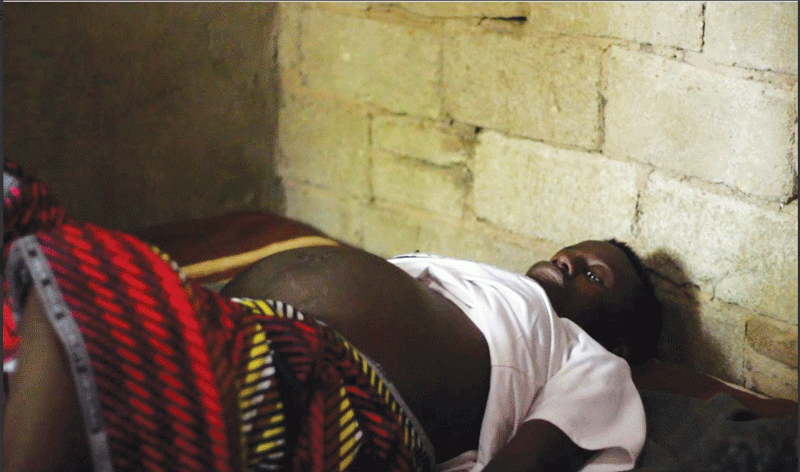
IN Zimbabwe’s rural remote villages, a silent epidemic is afflicting several women, leaving them isolated, ashamed and desperate for attention.
Characterised by continuous urine leakage and unpleasant odour, obstetric fistula has been stealing the dignity of Janet Munetsi* (22) since 2019.
Hailing from a small village of Nyamhondo in Mberengwa, Midlands province, Munetsi’s ordeal started after she gave birth to a bouncing baby boy.
This is the third story of a series, The high cost of motherhood: A silent maternal health care epidemic in Zimbabwe,” supported by the International Women’s Media Foundation’s Howard G Buffett Fund for Women Journalists.
As an orphan after losing parents to a cruel twist of fate, Munetsi now faces a different kind of tragedy — one that has stolen her dignity and silenced her cries.
“I had accepted my fate because I had no name to call it. All I knew was that I had been experiencing leakages of urine and I could not control it,” she told NewsDay.
This is how countless women in Zimbabwe find themselves ensnared by the silent suffering of obstetric fistula, often unaware of this debilitating condition.
The World Health Organisation (WHO) describes obstetric fistula as an abnormal connection between the vagina, rectum, and/or bladder which may develop after prolonged and obstructed labour.
- Mavhunga puts DeMbare into Chibuku quarterfinals
- Bulls to charge into Zimbabwe gold stocks
- Ndiraya concerned as goals dry up
- Letters: How solar power is transforming African farms
Keep Reading
If not corrected, it leads to continuous urinary or faecal incontinence.
Globally, obstetric fistula affects between 50 000 and 100 000 women annually, with low-income countries in Africa and Asia bearing the brunt of the condition.
Although the actual rate of obstetric fistula in Zimbabwe is unknown due to a lack of awareness among the populace, it is reasonable to assume that the country has a devastating prevalence and incidence rate given the country’s high maternal mortality ratio, as reported by the most recent Multiple Indicator Cluster Survey from 2019.
Munetsi’s condition started when she got into labour alone when she was working at a farm as a caretaker in Masvingo.
“When I started experiencing labour pains, I was alone at home and my phone battery was flat because I could not go to one of our neighbours where I used to charge my phone.
“My body was just weak and I wasn’t in the mood of going out of the house,” she said.
Little did she know that it was time to give birth.
“The labour worsened at around 11pm, but I could not call for help and even if I wanted to, the local hospital was at a distance that I could not walk there alone at night,” she said.
“Throughout the night, I could not sleep a wink. I was in so much pain.”
Munetsi’s waters broke early in the morning, but still, the baby had not yet arrived.
In the morning when a young boy came to her house to ask for a lighter to make fire as he was preparing to go to school, he could not find her and went back home to tell his mother that he could not find her.
“Considering that I had spent a night in the grip of overwhelming emotions, my voice had faltered, lost amid tears. When the boy knocked, I fought to find the voice, but I couldn’t say anything. That is why the boy went back home and told her mother that he could not find me,” Munetsi said.
Knowing the condition that Munetsi was in, the boy’s mother rushed to check on her.
She forcefully opened Munetsi’s hut and found her weary, lying in a pool of water.
In a frantic rush, she took her to hospital, only to find the maternal ward overflowing with patients.
“I could not get admitted right away as the maternity ward was fully booked and all the midwives were attending to other patients,” Munetsi told NewsDay.
Despite the chaos at the health institution, she gave birth to a baby boy.
However, this joyous moment was overshadowed by a lingering condition — one she would endure silently for nearly a year.
Munetsi’s journey was not just physical.
It was a case of multiple situations where, on the other hand, she had to face the societal norms that perpetuated silence around obstetric fistula.
Meanwhile, she suffered the misconceptions that labelled her as cursed.
In September 2020, Munetsi’s fate changed when a young lady who had visited their village for the holidays became her saviour.
“I always call this lady a good Samaritan. She encouraged me to go and seek medical attention and that is when I was referred to Parirenyatwa [Group of Hospitals], where I got operated on,” Munetsi said.
She did not know that obstetric fistula was a medical condition that could be rectified.
Although obstetric fistula repair was made official in Zimbabwe in 2015 as a public health initiative, not much has been done to increase public awareness of the problem.
According to a new study by Amnesty International, many women and girls in Zimbabwe have limited access to maternal healthcare, which may help to avoid obstetric fistula, as well as treatment for the condition.
“Our research has revealed that obstetric fistula appears to affect the most marginalised members of the society: poor, young and often illiterate girls and women in remote regions of the country. And this is where access to maternal health is limited as most people live far from public health facilities,” said Roselina Muzerengi, campaigns co-ordinator at Amnesty International.
Mercy Rukudzo* of Chirumanzu in the Midlands province also endured the misery that comes along with having an obstetric fistula.
“I’ve had genital sores for the past two years and the wetness is stopping them from healing. I’m terrified to go out in public,” she said.
“The last time I attended a function, the terrible odour made people shy away from me.
“It repulsed them. I’m limited to this place so that I can take a shower whenever I urinate.”
Obstetric fistulas, which are caused by obstetric causes, usually prolonged and obstructed labour, are an abnormal communication between the urinary tract or the gastrointestinal tract and the genital tract, and are referred to as the “most devastating birth injury” by both the WHO and the United Nations Population Fund.
According to the WHO, obstetric fistulas are treatable provided they receive high-quality care.
However, amid an ever-worsening economic situation in Zimbabwe, as well as the country’s consistently low healthcare budget allocation, the situation is dire, according to Parliamentary Portfolio Committee for Health and Child Care, chairperson Daniel Molokele.
“Recently, we toured several government health institutions as well as those for mission hospitals. The impression we got there was devastating, a sign that shows that the government of Zimbabwe has failed to assign sufficient resources to the health sector,” Molokele said.
Despite declaring a policy of free maternal services, this sector has not been fully funded or operationalised with relevant initiatives.
In the end, obstetric fistula prevalence and incidence serve as markers of a nation’s health system’s inability to provide women and girls with timely, appropriate and accessible maternal care, thus breaching their right to health.
Molokele said as Parliament, their role in such situation was to urge the government to adequately fund and operationalise a comprehensive public maternal healthcare policy, ensuring such policy is in line with the international standards of availability, accessibility, acceptability and quality.
*Not their real names











